Tourist attractions
National Lighthouse Museum
National Lighthouse Museum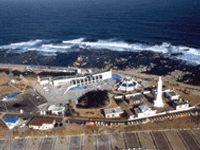
Location
20, Haemaji-ro 150 beon-gil, Homigot-myeon, Nam-gu, Pohang-si 054)284-4857
Tour Information
- Opening Hours : 9:00am ~ 6:00pm (Last admission 5:30pm)
- Admission Fees : Free
- Estimated Time Required for Tour : 1 hour 30 minutes
- Closed
- The Lunar New Year’s Day, The Korean Thanksgiving Day, every Monday
- Outdoor Exhibition Area is open
Transportation
- Take an express city bus no.200 or 200-1 to Guryongpo and get off at Guryongpo Transfer Center. Take a city bus bound for Daebo and get off at Homigot (16 buses per day)
- Take the National Highway Route 31 to Guryongpo, Gampo. At Guryongpo Town, take the local road no.925 and drive for 20 minutes. The Museum is adjacent to the Homigot Sunrise Square.
Homigot Lighthouse
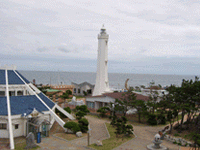
Introduction
- The Korean Peninsula is commonly identified as a tiger because of its shape. The Homigot Lighthouse is located in the tail part. This place is called ‘Homigot’ or ‘Dongoegot’, and it is also referred to as the ‘Daebo Lighthouse’ for it faces Yeongilman beach to the west and the East Sea to the east. The Homigot Lighthouse is the largest lighthouse in Republic of Korea, with a height of 26.4m, bottom circumference of 24m, and top circumference of 17m.
- The Lighthouse was built as an octagonal tower in a modern architectural style. As the building was built using bricks only and no reinforcing rods, it is still applauded by architects in the today’s world for its outstanding quality. The Lighthouse consists of 6 floors and the ceiling on each floor is sculpted in the shape of pear blossoms, a symbol of the Joseon Dynasty. The Homigot Lighthouse was built in the 7th year of King Gojong (1903), and thus it is the oldest lighthouse in Republic of Korea. This adds to the Lighthouse’s considerable value as an architectural and cultural asset.
Transportation
- Take an express city bus no.200 from the city center and get off at Guryongpo Transfer Center. Transfer to a bus bound for Homigot (40 minutes interval).
- Take the National Highway Route 31 from the city center to Guryongpo and Gampo. At Guryongpo Town, take the Local Road no.925 to Daebo. Drive for 20 minutes and the Lighthouse is located on the right.
Nayeonsan Mountain

Introduction
Naeyeonsan Mountain (710m) is located in the southern Taebaek Mountains. From this mountain, you can enjoy a view of the East Sea and the ancient Bogyeongsa Temple. When you reach the Gwaneum Falls after passing by the Ssangsaeng Falls, Sambo Falls, Boyeon Falls, and Jamyong Falls, you will find the Gwaneum Cave. After continuing over the viaduct, you will reach the Yeonsan Falls, the most magnificent and beautiful waterfall among the 12 waterfalls of Naeyeonsan Mountain. With its beautiful view of the valley and surrounding forests, Nayeonsan Mountain has become a popular tourist attraction.
The estimated time for hiking from Bogyeonsa Temple to Yeonsan Falls is approximately 2 hours (6km round-trip). As the hiking track is nicely polished, even children or elderly people can easily climb the Mountain.
Transportation
- Take an express city bus bound for Bogyeongsa Temple from Express Bus Terminal(Shinan Bus). 15 buses per day. (1 hour ride)
- Take the East Coast National Highway Route 7 from the Pohang city center to Yeongdeok, Uljin. At Songra-myeon, 30.8km along the highway, take the local road to Bogyeongsa Temple and drive for 4km.
Bogyeongsa Temple
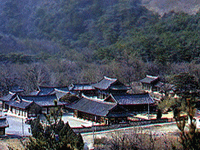
Introduction
Bogyeongsa Temple, located 4km northwest from Nayeonsan Mountain, gained its name ‘Bogyeonsa’ when Monk Iljo buried an eight-sided mirror 30 meters deep in the bottom of Yongdam Lake and established a temple on the same spot. The Temple is one of the top 8 sceneries of Gyeongbuk province, and its beautiful surroundings and 12 waterfalls attract many tourists.
Transportation
- Take an express city bus bound for Bogyeongsa Temple from Express Bus Terminal (1 hour ride)
- Take the East Coast National Highway Route 7 from the Pohang city center to Yeongdeok, Uljin. From Songra-myeon, 30.8km along the highway, take the local road to Bogyeongsa Temple and drive for 4km.
Oeosa Temple

Introduction
Oeosa Temple was established during the reign of King Jinpyeong, the 26th King of the Silla Dynasty, and its original name was ‘Hangsasa.’ The Temple gained its present name from a story that involves Monks Wonhyo and Hyegong. The two monks once had a competition to revive two fishes by using the power of buddhism. Only one of the two fishes came back to life, and both monks claimed that they were the one to revive the fish. Consequently, the name of the temple became ‘Oeosa: My Fish Temple.’ The Chinese characters that make up the name of the temple, ‘O (吾)’ and ‘Eo (魚)’, stand for ‘my’ and ‘fish.’
Transportation
- Take an express city bus no.102 or 300 bound for Ocheon from the city center (12 minutes intervals). Get off at the Old Ocheon bus stop and take a bus bound for Oeosa Temple (11 buses per day).
- Drive past POSCO from the city center and take the Local Road no.929 at the Cheongnim intersection. Drive for 4km from the Ocheon Town to Oeosa Temple.
Yeongildae Beach
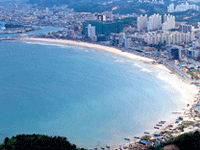
Introduction
Yeongildae Beach is the most well-known beach in Pohang, with a length of 1,750m, width of 40~70m, and area of 37,207㎡. POSCO and Yeongilman beach can be viewed from this beach, and the fine sand of the beach makes it a suitable summer holiday destination for families. As the beach is located near the city center, tourists can enjoy convenience facilities and accommodation in the Pohang City, as well as freshly caught seafood and sashimi.
Transportation
- Take an intercity bus no.200 or 105 from Intercity Bus Terminal (20 minutes ride)
- At the Ogeori intersection, 2km north from the city center, keep driving north for 3km until reaching the Yeongildae Beach entrance.
Chilpo Beach
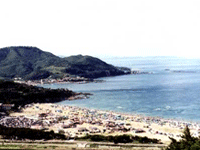
Introduction
Chilpo Beach is located 13km north from Pohang City. It is the largest beach on the East Coast and can accommodate 100,000 visitors per day, with a length of 2km, width of 70m, average water level of 1m, and total area of 97,000 pyeong. The sandy beach contains a high percentage of coarse sand and is a suitable spot for ocean fishing.
Transportation
- Take an intercity bus bound for Chilpo from Intercity Bus Terminal (50 minutes ride)
- Take the East Coast National Highway Route 7 from the city center. At the Gokgang intersection, 7km north from Pohang city center, take a right turn and drive for 6km.
Wolpo Beach
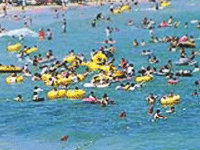
Introduction
Wolpo Beach can accommodate 50,000 visitors per day and has a length of 900m, width of 70m, and total area of 107,786㎡. The water is clean and shallow, and sleeping accommodation can be easily found on this beach. As the beach is where warm and cold currents meet, it is abundant in zooplankton, and thus oceanic fishes such as pacific saury are present. Consequently, fishing at the Wolpo Breakwater is an exciting activity where you can catch various oceanic fishes.
With its quiet atmosphere and clean water, the beach is attracting a growing number of visitors. POSCO Resort and Red Cross Youth Training Center are also located near the beach. Furthermore, if you travel along the coastline for 2km to the south, you can find Iga-ri Beach and a natural recreation area comprised of pine forest and rocks to enjoy sea bathing and a green shower
Transportation
- Take an intercity bus bound for Yeongdeok from the Pohang City. Get off at the Cheongha intersection (15km) and walk for 1.5km
- Take a city bus bound for Wolpo from Intercity Bus Terminal (during summer peak-season). 11 buses per day (bus no.500)
- Take the East Coast National Highway Route 7 from the city center and drive for 15km to Yeongdeok. At the Chengha intersection, take a right turn and drive for 1.5km
Hwajin Beach
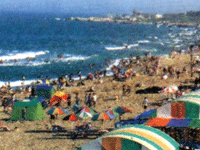
Introduction
Hwajin Beach is located 20km north from Pohang City, with a length of 400m, width of 100m, average water level of 1.5m, and total area of 10,000 pyeong. The beach can accommodate up to 50,000 visitors per day, and is a perfect place for summer vacations as it has numerous trees, clean water and beautiful scenery. Moreover, the 12 Falls of Bogyeonsa Temple are located near the beach, so visitors can enjoy the view of waterfalls and sea-bathing.
Transportation
- Take an intercity bus bound for Yeongdeok·Uljin from Pohang City to Hwajin Beach. Departure every 15 minutes. (50 minutes ride)
- Take the East Coast National Highway Route 7 from the city center to Yeongdeok and drive for 20km
Guryongpo Beach
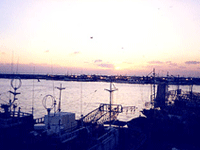
Introduction
On the map of the tiger-shaped Korean Peninsula, Guryongpo Beach is located on the tail part of the tiger. Surrounding the lake-like Yeongilman beach, the beach is positioned 24km away from Pohang City, and 1.5km from Guryongpo Town. The semicircle-shaped sandy beach has a length of 400m, width of 50m, and area of 6,000 pyeong, and can accommodate up to 10,000 visitors per day. The scenery along the coastline is beautiful, and visitors can enjoy the sunrise from Yeongilman beach and ocean fishing.
Transportation
- Take an express city bus no.200 or 200-1 from the city center. Get off at Guryongpo and walk for 10 minutes.
- Take a bus bound for Daebo. 8 buses per day. 5 minute ride.
- Take the National Highway Route 31 from Hyeongsangyo, Pohang, and drive for 20km to Guryongpo·Gampo. At Byeongpo-ri, take the local road and drive for 4km past Guryongpo Town.
Dogu Beach
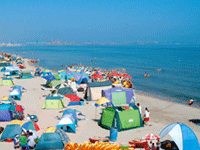
Introduction
Dogu Beach is famous for a legend called the ‘Yeonorang and Seonyeo.’ The beach stretches for 800m, with a width of 50m and area of 12,000 pyeong, and it can accommodate 25,000 visitors per day. As the beach is located near POSCO and can be conveniently accessed, it is favored by many schools and organizations as a summer training camp site.
Transportation
- Take an express city bus no.200 or 200-1 from the city center. Get off at Dogu and walk for 5 minutes.
- Take the National Highway Route 31 from the city center and drive for 9km to Guryongpo. At Dogu-ri, take the local road and drive for 700m.
Yeongildae Beach Seafood Center
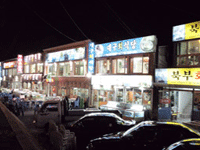
Introduction
At Yeongildae Beach, visitors can taste Pohang City’s famous Mulhoe (cold raw fish soup) and assorted raw seafood from over 50 seafood restaurants. The Beach is famous for its beautiful night view, as it faces Songdo Beach, POSCO, and Hwanho Sunrise Park. Tourists can enjoy the ocean view while indulging in fresh seafood from more than 80 seafood stores and restaurants on the beach.
Transportation
- Take an intercity bus no.105 or 200(Departure every 5-10 minutes) and get off at the Yeongildae Beach entrance.
- Take express bus no.101 or 200-1 and get off at the Yeongildae Beach entrance.
Jukdo Sashimi Town
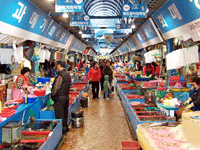
Introduction
Jukdo Sashimi Town is located in the Jukdo Seafood Market, the largest market on the East Coast that is located 500m east from Ogeori, the center of Pohang. Inside the Market, more than 200 sashimi shops can be found so visitors can purchase fresh sashimi at reasonable prices in all seasons. Visitors can immediately taste their purchased sashimi at nearby restaurants by paying a table-setting fee for side dishes and sauce. During the winter season, tourists can taste Gwamegi (half-dried billfish), the famous specialty of Pohang.
Transportation
- Every city bus stops at the Jukdo Seafood Market
- 4-5km drive to the northeast from the city center. The market can be reached within 10-15 minutes from anywhere in the city, and the expressways from all directions enable easier access to the market.

